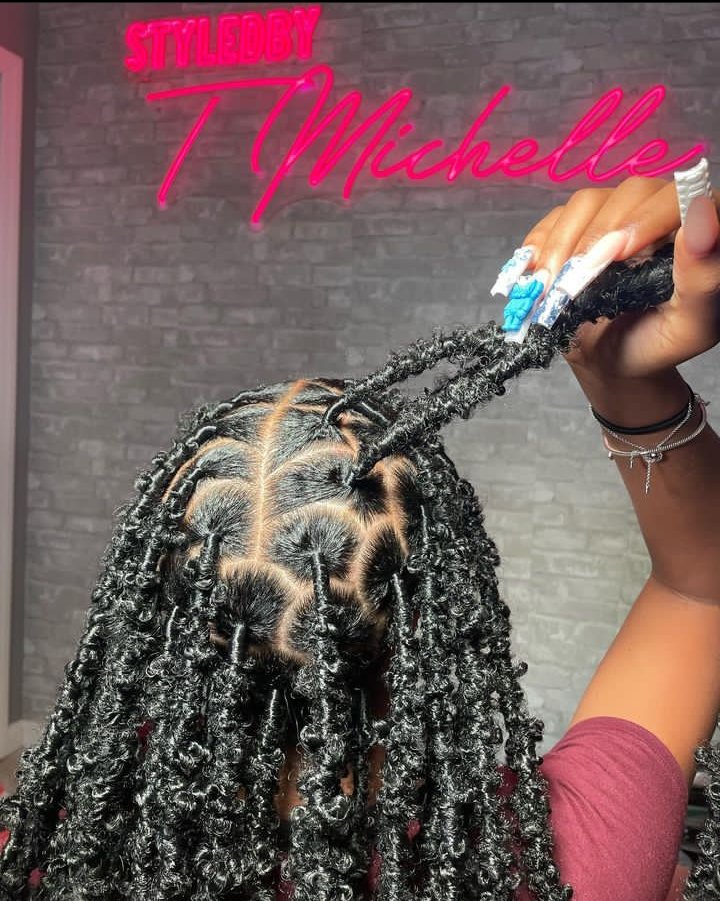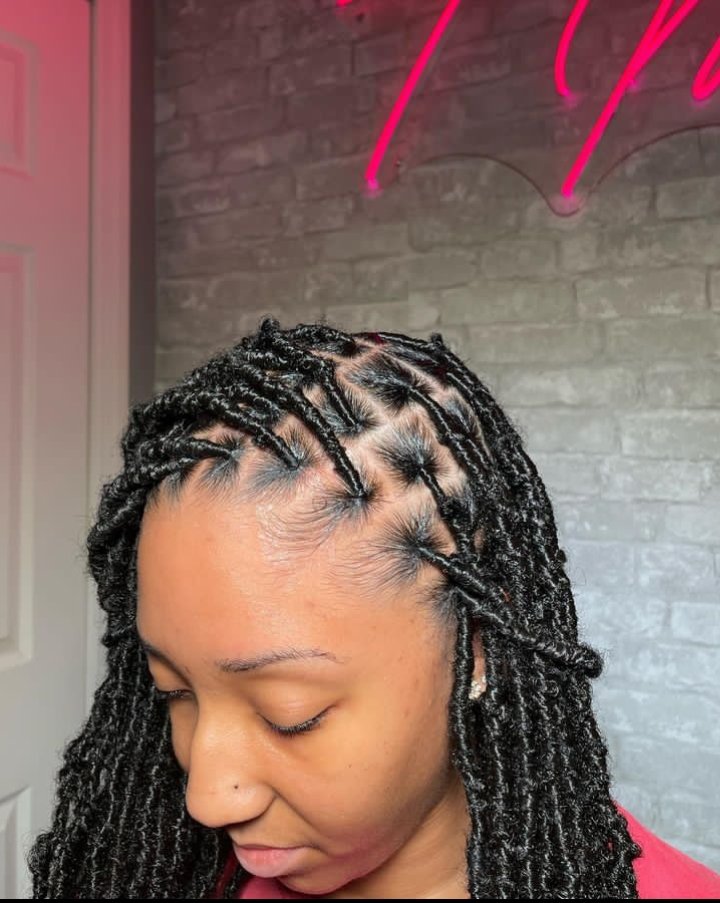Faux Locs
Butterfly Locs for Beginners: Everything You Need to Know
Butterfly locs are a beautiful and low-maintenance hairstyle. However, proper care and maintenance are still necessary to keep them looking their best. In this guide, we’ll walk you through the steps to maintain your butterfly locs and keep them healthy, beautiful, and shiny.
What Are Butterfly Locs?

Butterfly locs, also known as butterfly braids, are a type of braided hairstyle that originated in Africa and were commonly worn by people of African descent. They gained popularity in the United States in the late 1990s and early 2000s and continue to be a popular hairstyle today.
The name “butterfly locs” comes from the butterfly-like pattern created by the braids, which resemble the wings of a butterfly. The hairstyle is often associated with the Rastafarian culture and is also a symbol of cultural pride for many African Americans.
Benefits of Butterfly Locs
- Low maintenance: Butterfly locs are low maintenance, as they require minimal care routine and are typically longer lasting.
- Versatile styling: Butterfly locs can be styled in many different ways, as would box braids.
- Natural look: The distressed curly loop of butterfly locs look natural, making them an attractive option for those who want to maintain a more natural look.
- Easy to install: Butterfly locs are easy to install, as they do not require any braiding or cornrowing, making them a convenient option for those who want to start their loc journey.
- Affordable: Compared to other loc styles, butterfly locs are relatively affordable, making them an attractive option for those who are on a budget.
- Protective style: Butterfly locs are a protective style that helps to prevent hair breakage and damage, making them ideal for those who want to maintain the health of their hair.
- Lightweight: Butterfly locs are lightweight and not heavy, which makes them comfortable to wear and reduces the risk of headaches or scalp discomfort.
How to Create Butterfly Locs

Creating butterfly locs is a multi-step process that can take several hours depending on the length and thickness of your hair. Here is a general guide on how to create butterfly locs:
To begin butterfly locs, start with clean, dry hair that has been detangled, and parted into small sections. There are two known techniques for butterfly loc, the thumb method, and the pull method.
For the thumb method, take a small section of hair, apply a braiding gel or shine n jam and divide it into three pieces, and braid by placing one section over the other. For natural folks, who complain about unraveling the butterfly locs, you could twist instead, to help with the unraveling process.
To twist, split the hair section into three bits starting by braiding the hair at the root afterward, split a piece and add to the other two pieces and layer the halves over the other. It only matters if it is super tight at the roots.
Grab a faux loc, open the loop, and with the crochet hook inserted at the root of the braid, pull the loop through the crochet needle. Take the end of the faux locs and crochet them through the top of the loop, pulling it through to secure the loc. Take two strands of passion twist, and run your hands through them to gently untangle and smoothen the piece. Crochet in the passion twists through the braid roots, making sure one piece is longer than the other. The longer one would serve as the wrapping hair.
Wrap around tightly three to four times, and stick your thumb in the middle of the wrapping hair, also, passion twists can make a rather unique style.
Continue wrapping under the thumb a couple of times, afterward take the thumb out and a loop has been created. Continue wrapping downward and creating as many loops as you desire until you are almost out of hair.
Once you get to the end, tie a knot and wrap the remaining piece upwards, and then you palm roll.
The pull method on the other hand is relatively less time-consuming, however, does require a higher level of expertise. For the pull method, you’ll alternate between wrapping tightly and loosely, after which you’ll tug at the locs to make a loop. It is easy to mess up this look if you are not a pro at this, for newbies, the thumb method is recommended.
How long does It take to install Butterfly Locs?
The time it takes to install butterfly locs varies depending on several factors such as the size of the head, the length of the hair, the technique used, and the experience of the stylist. On average, it takes about 4-8 hours to install butterfly locs.
Prepping for butterfly locs
Prepping for butterfly locs involves several important steps to ensure that the hair is properly prepared for the installation of the locs. The first step is to thoroughly clean the hair and scalp to remove any buildup or oils that may interfere with the locs. Then, the hair is often detangled, combed and divided into small sections that are then twisted or braided into large chunks.
You also need to purchase the hair ahead of your appointment with a stylist. The number of packs of hair needed for butterfly locs depends on the desired fullness and length of the style, as well as the size of the head. Typically, 2-4 packs of hair are sufficient for a full head of butterfly locs. However, it is always best to consult with a stylist to determine the exact amount of hair needed for your specific needs.
You might be interested in: How Many Packs of Hair for Soft Locs
How to Maintain Butterfly Locs

Maintaining butterfly locs requires regular care to keep them looking their best. However, before we delve into the tips for maintaining your butterfly locs, let’s take a look at the importance of maintaining the butterfly locs.
- To maintain their shape and appearance
- To prevent breakage and damage
- To promote hair growth
- To ensure the locs are clean and free of buildup
- To prevent tangling and matting
- To maintain the health of the scalp and hair.
Can butterfly locs be washed? This is another frequent question from newbies and that is yes. Washing butterfly locs or any other locs, is an essential care tip that shouldn’t be neglected to preserve and protect the hair.
To wash butterfly locs, follow these steps:
Wet hair with lukewarm water and apply a sulfate-free shampoo to the scalp, avoiding the locs themselves. The sulfate-free shampoo contains milder surfactants and so is not overly stripping of the hair’s natural oils. Gently massage the scalp for 2-3 minutes and rinse thoroughly.
Repeat shampoo if needed.
Apply a moisturizing conditioner to the hair following the wash and rinse the conditioner thoroughly with cool water. Afterward, gently blot hair with a microfiber towel to remove excess water and prevent tangling.
Other care tips for the maintenance of butterfly locs include:
- Keep them clean: Regular shampooing and conditioning are important to keep your locs clean and healthy. You can use a residue-free shampoo and a light conditioner to keep your hair moisturized.
- Moisturize: Keeping your locs moisturized is important to prevent dryness, breakage, and frizz. Massage in hair oils such as almond, jojoba, coconut, or olive oil into the scalp, helps with blood circulation to the hair follicles and promotes healthy hair development.
- Retwist: Retwisting your locs every 4-6 weeks will help to keep them tight and maintain their shape.
- Applying a mousse to your butterfly locs periodically will help keep them appearing tidy.
- Keep them protected: Covering your locs with a silk or satin scarf or wrap at night will protect them from friction and prevent tangling.
- Avoid tight hairstyles: Avoid pulling your locs back into tight ponytails or updos, as this can cause breakage.
- Be gentle: Handle your locs gently when styling and avoid using a lot of heavy products on them as it can cause buildup and tangles.
- You might also need to remove certain locs, put them back in, and use edge control.


